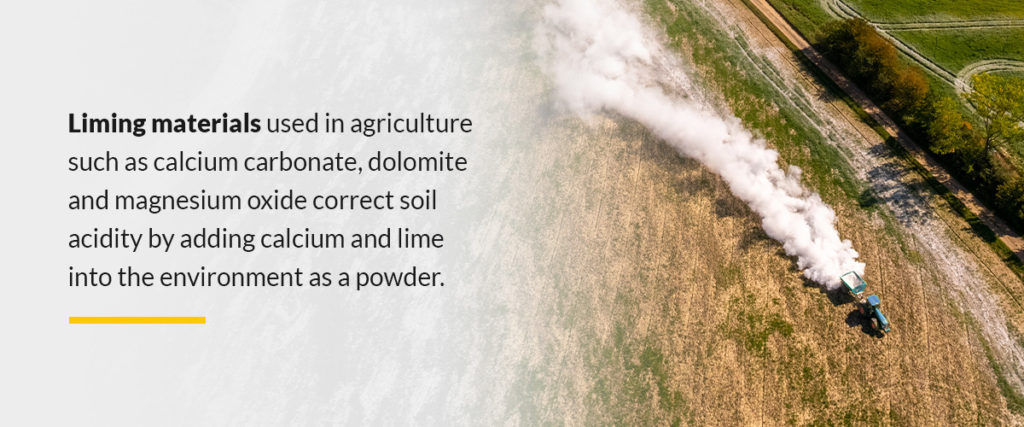Understanding the chemical balances of your soil can mean the difference between a healthy growing season and sprouts that are not strong enough to survive the year. The pH levels in your soil regulate the nutrients your crops need to grow, distribute seeds and produce food. Soil acidity is a prevalent issue for many farmers who notice a decrease in healthy crops.
To reduce soil acidity, understand how this common farming complication occurs and how to combat it. While stabilizing the pH levels in your soil can take anywhere from a few months to a year or so, the results can benefit the success of your harvest for years to come.
What Causes Soil Acidity?
The chemical pH scale from 1-14 measures the chemical properties of liquid solutions. The lower numbers represent the acidic side of the pH scale, the higher ones indicate alkaline and the middle is a neutral balance of both chemical levels. Typically, plants thrive best in neutral soil, measuring around 6 or 7 on the soil pH scale. This balance offers crops different nutrients including iron, magnesium, nitrogen and sulfur.
The effects of soil pH on plant growth range from healthy harvests to an empty field of crops that could not grow due to a lack of these nutrients. The lower acidity levels can cause plants to weaken over time because of the lack of these nutrients. The acidic soil cannot provide crops with these necessities, decreasing the likelihood of a prosperous harvesting season.
Soil becomes more acidic from the properties that naturally seep into the ground. Soil acidity can result from:
- Harvesting high-yielding crops: The plants that produce a large amount of food each year during harvest, including corn, potatoes and rice, absorb more nutrients in the ground needed to thrive. The acidity in the soil increases due to the lack of calcium, sodium and magnesium.
- Leaching: Too much water can impact the soil’s ability to provide nutrients to crops. Excess water from rainfall or irrigation seeps deeper into the ground, carrying these nutrients away from plants. The soil then becomes acidic without calcium, magnesium and sodium.
- Acidic rainfall: Rainfall can be naturally acidic. In some instances, precipitation can also strip the soil of the calcium, magnesium and sodium plants consume to survive.
- Decomposing organic matter: Cells and tissues from plant and animal life can decompose over time, emitting high carbon dioxide (CO2) levels. Too much CO2 can limit plant growth from the increased acidity in the soil.
- Dissolving roots: When plants can no longer grow after years of harvesting, the roots begin to wither and dissolve. The root matter infiltrates the water in the soil and makes it more acidic.
- Unbalanced fertilizers: Some fertilizer properties are best suited for plants that prefer higher acidity, such as fruits and flowers. The soil will become more acidic when farmers use this fertilizer around crops with neutral pH levels without checking the chemical properties first. It is crucial to check each fertilizer’s chemical compounds before use.
How to Reduce Soil Acidity
The first step to correcting soil acidity is to measure how your soil places on the pH scale. Determining where your soil falls in acidic, neutral and alkaline levels can make combating this issue easier. Most hardware stores sell pH tests that provide accurate results.
The test itself is also easy to conduct. You will place a sample amount of soil into a test tube, insert the correct dyes and amount of water based on the instructions and notice the tube begins to change colors.
After waiting a few minutes for the results, most tests will show a red, orange or green. Usually, darker red indicates a high level of soil acidity, orange represents low acidity and green means your soil is neutral. Based on these results, you can begin to explore your options for the best correction to your soil’s chemical properties.
The most effective treatment for soil acidity is fertilizing the ground using limestone. Liming materials used in agriculture such as calcium carbonate, dolomite and magnesium oxide correct soil acidity by adding calcium and lime into the environment as a powder.
Farmers favor using side spreaders to distribute liming materials into the soil. This tractor attachment holds the limestone in a large container and spreads the powder in a fan-like array to cover as much soil as possible. This application method helps restore the chemical properties in the ground to help crops receive the nutrients they need faster and more effectively.

How Agricultural Lime Works
When natural processes such as leaching and organic matter decomposition take the calcium, sodium and magnesium from the soil, the acidity levels begin to rise. When soil doesn’t retain these chemicals, it can’t supply plants with the nutrients they need. Correcting the acidity through lime can help restore the soil’s ability to produce healthy crops for many years.
When your soil has become too acidic to grow crops each year effectively, you can take a few approaches to combat this presence in the ground. Luckily, because the pH scale determines the soil’s acidity, you can balance the chemical properties by incorporating neutral or alkaline compounds.
Agriculture lime contains several chemical properties such as zinc, phosphorus, calcium and magnesium that increase the soil’s pH levels over time. Because most crops thrive at neutral pH levels, it is essential to maintain this chemical balance to produce healthy plants.
For example, the most commonly grown crops in the United States and their normal growth pH levels include:
- Corn: 5.8-7
- Oats: 5.8-7
- Wheat: 6.3-7
- Barely: 6.3-7
- Soybeans: 6.5-7.5
Even though slight acidity benefits some crop growth for plants such as fruit, neutral pH levels can benefit all plants. Vegetables that produce healthy foods need a balance between acidic and alkaline levels, which lime spreading can provide. Lime application increases soil pH rates to 6 and 7.
Industries Served
Spreaders are a great solution to distributing limestone quickly and effectively. They can also provide benefits in various environments outside of crop growth. Spreaders maintain the land around cemeteries, golf courses, vineyards and parks to produce miles of fields with healthy green grass.
Even dry areas such as mines, quarries and power stations see impressive improvement from mounds of dirt to flowing fields of agriculture. Animals benefit immensely from the use of spreaders, as they feast on the growing grass in wildlife sanctuaries and empty plots of land. Spreaders provide satisfying results in various environments.
Trust Sides Spreader to Fit Your Agriculture Needs
Understanding your soil’s pH levels is the first step to having a successful harvest. If you discover high acidic levels in your fields, contact Sides Spreader for easy and practical limestone application. Our tractor attachments make spreading lime simple, so you can get back to growing healthier crops in no time.
Our lime broadcast spreaders can handle rough terrain to ensure lime spreads across as much land as possible. Each season, you can rest assured that your farmland, vineyard or any patch of land receives the proper nutrients for maximizing healthy growth.
Call us today or fill out our contact form with any questions about our spreaders.



